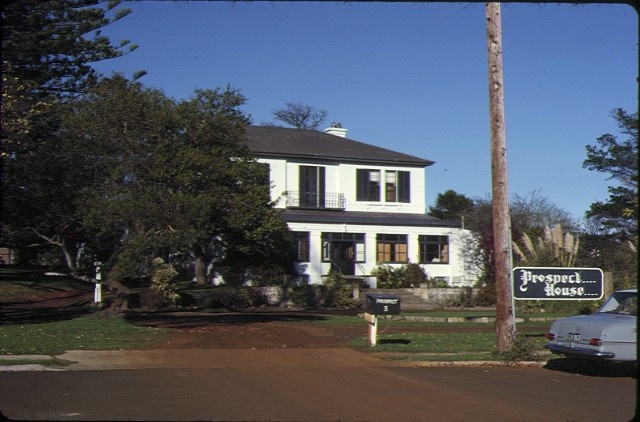PROSPECT
2 PROSPECT COURT AND 3 PROSPECT COURT PORTLAND, GLENELG SHIRE
-
Add to tour
You must log in to do that.
-
Share
-
Shortlist place
You must log in to do that.
- Download report



Statement of Significance
What is significant?
In December 1800, Lieutenant James Grant on board the Lady Nelson sighted a wide bay which he named Portland Bay after a Secretary of State, the Duke of Portland. The bay had an abundance of seals and whales and by the early 1830s, sealers and whalers had established a whaling station and trading port on the bay. As the richness of the grazing hinterland became apparent, pastoralists took up land in the area. On the favourable advice of Foster Fyans, the Police Magistrate for Geelong with regard to the long-term future of the settlement, the government commenced the set out of a new township in 1840.
The two storey brick mansion house Prospect was erected to a design by local architect George Mathewson in 1855 for Thomas Must, a wealthy merchant who had in 1845 journeyed from Sydney to establish a Portland branch of the merchant firm Must and Flower. The firm constructed a substantial warehouse in Bentinck Street in 1845-46 which was expanded as the fortunes of both Must and the township grew. Thomas Must and his architect George Mathewson would have been well-known to each other, as both men been approached in 1847 to be trustees of the local branch of the Port Philip Savings Bank. In 1878, the original posted verandah at the front of the house was replaced by a new verandah and conservatory to a design by architect Daniel Nicholson who had been responsible for the design of the prominent Assembly Rooms to the London Inn [VHR H0237].
Thomas Must was an active participant in Portland affairs from its earliest days. In addition to his role as a trustee of the Port Philip Savings Bank, Must was also a Justice of the Peace, treasurer to St Peter?s Church at Bridgewater, and the first chairman of the Borough Council. Thomas Must resided at Prospect for about fifty years and died at his home in 1905. Later owners included B Cunningham, G S Beresford, who named the house Waterford, and long-term Liberal Senator Sir Magnus Cormack who was President of the Senate from 1971 to 1974. In 1976, the house became an aged accommodation centre.
Prospect is a two storey mixed Regency/Italianate styled stuccoed house with an enclosed single storey verandah and a single storey kitchen wing. A single storey former stable block stands at the rear. The original character of the residence has suffered through alterations over time and its land has been reduced. The internal layout, fittings and finishes have been substantially altered. The stables have been extended for residential accommodation.
How is it significant?
Prospect is of historical significance to the State of Victoria.
Why is it significant?
Prospect is of historical significance through its association with the early Portland merchant Thomas Must, who was a prominent businessman and active participant in local affairs, acting as a bank trustee, Justice of the Peace, treasurer to St Peter?s Church at Bridgewater and first chairman of the Borough Council. Prospect is also important for its association with the long-term Liberal Senator Sir Magnus Cormack who was President of the Senate from 1971 to 1974.
[Online Data Project Upgrade 2005]
-
-
PROSPECT - History
In December 1800, Lieutenant James Grant on board the Lady Nelson sighted a wide bay which he named Portland Bay after a Secretary of State, the Duke of Portland. The bay had an abundance of seals and whales and by the early 1830s, sealers and whalers had established a whaling station and trading port on the bay. As the richness of the grazing hinterland became apparent, pastoralists took up land in the area. On the favourable advice of Foster Fyans, the Police Magistrate for Geelong with regard to the long-term future of the settlement, the government commenced the set out of a new township in 1840.
The two storey brick mansion house Prospect was erected to a design by local architect George Mathewson in 1855 for Thomas Must, a wealthy merchant who had in 1845 journeyed from Sydney to establish a Portland branch of the merchant firm Must and Flower. The firm constructed a substantial warehouse in Bentinck Street in 1845-46 which was expanded as the fortunes of both Must and the township grew. Thomas Must and his architect George Mathewson would have been well-known to each other, as both men been approached in 1847 to be trustees of the local branch of the Port Philip Savings Bank. In 1878, the original posted verandah at the front of the house was replaced by a new verandah and conservatory to a design by architect Daniel Nicholson who had been responsible for the design of the prominent Assembly Rooms to the London Inn [VHR H0237].
Thomas Must was an active participant in Portland affairs from its earliest days. In addition to his role as a trustee of the Port Philip Savings Bank, Must was also a Justice of the Peace, treasurer to St Peter’s Church at Bridgewater, and the first chairman of the Borough Council. Thomas Must resided at Prospect for about fifty years and died at his home in 1905. Later owners included B Cunningham, G S Beresford, who named the house Waterford, and long-term Liberal Senator Sir Magnus Cormack who was President of the Senate from 1971 to 1974. In 1976, the house became an aged accommodation centre.
Prospect is a two storey mixed Regency/Italianate styled stuccoed house with an enclosed single storey verandah and a single storey kitchen wing. A single storey former stable block stands at the rear. The original character of the residence has suffered through alterations over time and its land has been reduced. The internal layout, fittings and finishes have been substantially altered. The stables have been extended for residential accommodation.
The draft statement of significance and the above history were produced as part of an Online Data Upgrade Project 2005. Sources were as follows:
Gwen Bennett. Portland; Now & Then…1993
Noel Learmonth. The Portland Bay Settlement. 1983
J G Wiltshire. Twenty Years in an Hour-Glass…1980
Australian Heritage Commission. Register of the National Estate
PROSPECT - Permit Exemptions
General Exemptions:General exemptions apply to all places and objects included in the Victorian Heritage Register (VHR). General exemptions have been designed to allow everyday activities, maintenance and changes to your property, which don’t harm its cultural heritage significance, to proceed without the need to obtain approvals under the Heritage Act 2017.Places of worship: In some circumstances, you can alter a place of worship to accommodate religious practices without a permit, but you must notify the Executive Director of Heritage Victoria before you start the works or activities at least 20 business days before the works or activities are to commence.Subdivision/consolidation: Permit exemptions exist for some subdivisions and consolidations. If the subdivision or consolidation is in accordance with a planning permit granted under Part 4 of the Planning and Environment Act 1987 and the application for the planning permit was referred to the Executive Director of Heritage Victoria as a determining referral authority, a permit is not required.Specific exemptions may also apply to your registered place or object. If applicable, these are listed below. Specific exemptions are tailored to the conservation and management needs of an individual registered place or object and set out works and activities that are exempt from the requirements of a permit. Specific exemptions prevail if they conflict with general exemptions. Find out more about heritage permit exemptions here.Specific Exemptions:General Conditions: 1. All exempted alterations are to be planned and carried out in a manner which prevents damage to the fabric of the registered place or object. General Conditions: 2. Should it become apparent during further inspection or the carrying out of works that original or previously hidden or inaccessible details of the place or object are revealed which relate to the significance of the place or object, then the exemption covering such works shall cease and Heritage Victoria shall be notified as soon as possible. Note: All archaeological places have the potential to contain significant sub-surface artefacts and other remains. In most cases it will be necessary to obtain approval from the Executive Director, Heritage Victoria before the undertaking any works that have a significant sub-surface component.General Conditions: 3. If there is a conservation policy and planall works shall be in accordance with it. Note:A Conservation Management Plan or a Heritage Action Plan provides guidance for the management of the heritage values associated with the site. It may not be necessary to obtain a heritage permit for certain works specified in the management plan.
General Conditions: 4. Nothing in this determination prevents the Executive Director from amending or rescinding all or any of the permit exemptions. General Conditions: 5. Nothing in this determination exempts owners or their agents from the responsibility to seek relevant planning or building permits from the responsible authorities where applicable. Minor Works : Note: Any Minor Works that in the opinion of the Executive Director will not adversely affect the heritage significance of the place may be exempt from the permit requirements of the Heritage Act. A person proposing to undertake minor works must submit a proposal to the Executive Director. If the Executive Director is satisfied that the proposed works will not adversely affect the heritage values of the site, the applicant may be exempted from the requirement to obtain a heritage permit. If an applicant is uncertain whether a heritage permit is required, it is recommended that the permits co-ordinator be contacted.
-
-
-
-
-
BURSWOOD
 Victorian Heritage Register H0240
Victorian Heritage Register H0240 -
DWELLING
 Victorian Heritage Register H0727
Victorian Heritage Register H0727 -
FORMER PORTLAND INN
 Victorian Heritage Register H2071
Victorian Heritage Register H2071
-
'Altona' Homestead (Formerly 'Laverton' Homestead) and Logan Reserve
 Hobsons Bay City
Hobsons Bay City
-
-












